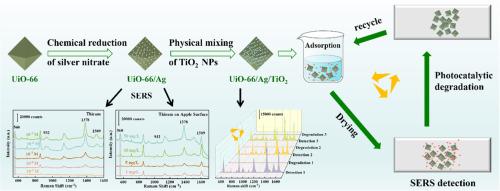Dual-function UiO-66/AgNPs/TiO2 SERS substrate with photocatalytic self-cleaning for recyclable detection of thiram
IF 6.3
2区 材料科学
Q2 CHEMISTRY, PHYSICAL
引用次数: 0
Abstract
Thiram, a cost-effective pesticide widely used for disease control in agricultural produce, poses potential health risks, necessitating the development of rapid surface-sensing techniques. Herein, a recyclable ternary surface-enhanced Raman scattering (SERS) substrate was developed by combining UiO-66/AgNPs with TiO2 nanoparticles. The optimized UiO-66/AgNPs composite (S10) demonstrated excellent SERS performance, achieving a detection limit of 10−11 M for rhodamine 6 G (R6G), with a wide linear range (10⁻⁶ to 10⁻¹¹ M, R² > 0.99), high signal uniformity (relative standard deviation < 10 %), and good temporal stability. The enhancement mechanism is attributed to the synergistic effects of analyte enrichment by the porous UiO-66, electromagnetic enhancement from AgNPs via localized surface plasmon resonance and nanogap effects, and chemical enhancement through charge transfer at the Ag–UiO-66 interface. Practical detection capabilities of S10 were confirmed with thiram detection limits of 10−9 M in laboratory conditions, 10−8 M in lake water, and 1 mg/L on apple surfaces. Further incorporation of TiO₂ nanoparticles yielded the S10T substrate, which not only improved SERS activity but also enabled photocatalytic self-cleaning. The S10T substrate maintained high performance over three consecutive detection-degradation cycles, retaining 89.2 % of the thiram characteristic peak intensity at 560 cm−1 after the third cycle, thereby demonstrating excellent recyclability and great potential for practical applications.

光催化自清洁双功能UiO-66/AgNPs/TiO2 SERS衬底用于可回收检测硫
Thiram是一种广泛用于农产品疾病控制的具有成本效益的农药,具有潜在的健康风险,因此有必要开发快速表面传感技术。本文将UiO-66/AgNPs与TiO2纳米颗粒结合,制备了一种可回收的三元表面增强拉曼散射(SERS)衬底。优化后的uui -66/AgNPs复合材料(S10)表现出优异的SERS性能,对罗丹明6g (R6G)的检测限为10−11 M,线性范围宽(10⁻26至10⁻¹¹M, R²> 0.99),信号均匀性高(相对标准偏差<; 10%),时间稳定性好。这种增强机制归因于三种因素的协同作用:多孔UiO-66富集分析物、AgNPs通过局部表面等离子体共振和纳米间隙效应产生的电磁增强,以及Ag-UiO-66界面电荷转移产生的化学增强。S10在实验室条件下的检出限为10 ~ 9 M,在湖水中为10 ~ 8 M,在苹果表面为1 mg/L,证实了S10的实际检测能力。进一步掺入tio2纳米颗粒得到S10T底物,不仅提高了SERS活性,而且实现了光催化自清洁。S10T衬底在连续三个检测-降解循环中保持了高性能,在第三个循环后,在560 cm−1处保持了89.2%的特征峰强度,从而显示了出色的可回收性和巨大的实际应用潜力。
本文章由计算机程序翻译,如有差异,请以英文原文为准。
求助全文
约1分钟内获得全文
求助全文
来源期刊

Surfaces and Interfaces
Chemistry-General Chemistry
CiteScore
8.50
自引率
6.50%
发文量
753
审稿时长
35 days
期刊介绍:
The aim of the journal is to provide a respectful outlet for ''sound science'' papers in all research areas on surfaces and interfaces. We define sound science papers as papers that describe new and well-executed research, but that do not necessarily provide brand new insights or are merely a description of research results.
Surfaces and Interfaces publishes research papers in all fields of surface science which may not always find the right home on first submission to our Elsevier sister journals (Applied Surface, Surface and Coatings Technology, Thin Solid Films)
 求助内容:
求助内容: 应助结果提醒方式:
应助结果提醒方式:


